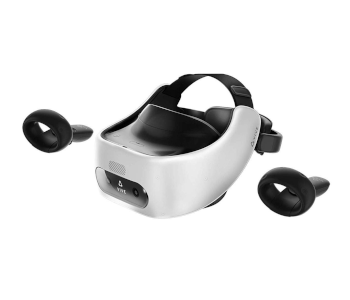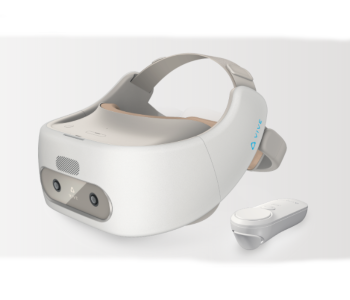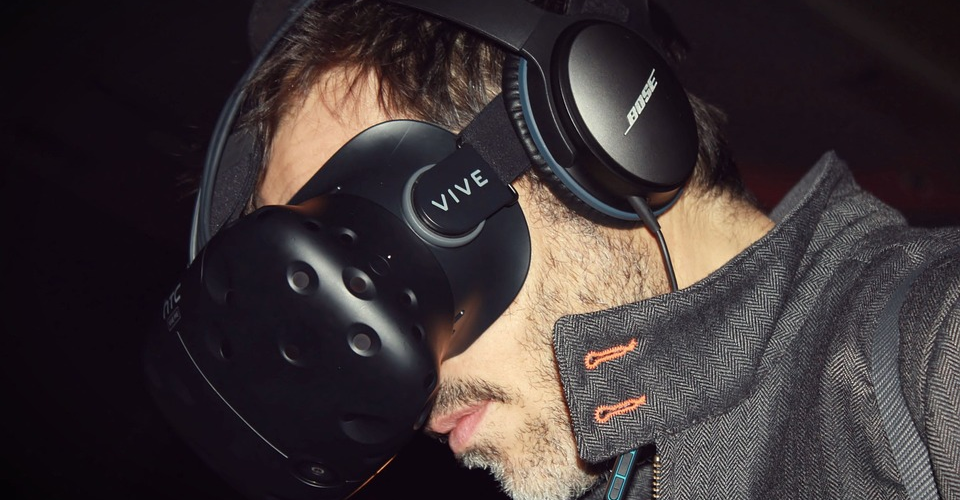HTC Vive VR Comparison: Pro vs Cosmos vs Focus vs Plus
It’s taken some time, but virtual reality is finally becoming the refined technology we have always wanted it to be, with several impressive VR headsets now available from a variety of different manufacturers. One of the most prominent names in this space is HTC, and in this guide, we will be comparing the company’s catalog of VR products to determine which option is best overall, and which option offers the most value.
Display Type
Using a VR headset requires you to place your eyes incredibly close to a display. For this reason, a VR headset must include a high-quality panel to reduce visible pixels, as well as any strain on your eyes that could occur from a poor resolution screen.
Currently, two display technologies are battling for the top spot in this space; OLED (Organic Light-Emitting Diode) panels and LCD (Liquid Crystal Display) panels. OLED panels work by using individual LED’s to light up each pixel, whereas LCD panels work using a backlight that is blocked by liquid crystal molecules to create images on the panel.
Generally, OLED panels are preferred for their ability to produce deeper blacks than their LCD counterparts. OLED panels also tend to have a better contrast ratio. However, LCD technology is continually evolving, and these days the differences between the two technologies from a performance perspective are minimal.
| Model | Display Type |
|---|---|
| HTC Vive | Pentile OLED |
| HTC Vive Pro | Pentile OLED |
| HTC Vive Cosmos | LCD |
| HTC Vive Focus | AMOLED |
| HTC Vive Focus Plus | AMOLED |
HTC Vive +1
HTC Vive Pro +1
HTC Vive Focus +1
HTC Vive Focus Plus +1
Resolution
Another important aspect of the display is its resolution. As we mentioned earlier, one of the more frustrating aspects of a VR headset is visible pixels. This is known as the “screen door effect,” as it creates the feeling that you are interacting with the virtual world through a mesh screen.
The easiest way to avoid this is to pick a VR headset with the highest resolution available. However, this isn’t always an option, especially if you are working with a tighter budget. Some VR products also list their resolution specifications per eye. If this the case, simply double the first number, and you will get the total resolution. For your convenience, this calculation has been included below.
| Model | Resolution |
|---|---|
| HTC Vive | 1080 x 1200 per eye (2160 x 1200 total) |
| HTC Vive Pro | 1440 x 1600 per eye (2880 x 1600 total) |
| HTC Vive Cosmos | 1440 x 1700 per eye (2880 x 1700 total) |
| HTC Vive Focus | 1440 x 1660 per eye (2880 x 1660 total) |
| HTC Vive Focus Plus | 1440 x 1600 per eye (2880 x 1600 total) |
HTC Vive Pro +1
HTC Vive Cosmos +1
HTC Vive Focus +1
HTC Vive Focus Plus +1
Field Of View

Field Of View (FOV) refers to the total viewing angle of the headset, i.e., how much of the virtual world you can see at any one time. For reference, the human eye has a horizontal field of view of around 135 degrees. This means that ideally, you want a VR headset that offers as close to this as possible.
If a headset has a field of view that is significantly less than this, a “tunnel effect” can occur. This creates the perception that you are viewing the display through a tunnel, resulting in a less immersive experience.
Most VR headsets have a field of view of around 100 degrees, which is decent but by no means perfect. VR headsets will undoubtedly improve in this area as the technology develops, but in the meantime, we recommend that you try to find a headset that offers a higher field of view, such as one of the HTC models below.
| Model | Field Of View |
|---|---|
| HTC Vive | 110 |
| HTC Vive Pro | 110 |
| HTC Vive Cosmos | 110 |
| HTC Vive Focus | 110 |
| HTC Vive Focus Plus | 110 |
HTC Vive +1
HTC Vive Pro +1
HTC Vive Cosmos +1
HTC Vive Focus +1
HTC Vive Focus Plus +1
Connection Type
It is common for a VR headset to require a PC-tether to run, and usually, this is achieved via an HDMI or DisplayPort connection. Wireless options are also starting to become more prominent in this space. However, as of right now, these headsets are somewhat lacking in performance compared to their tethered counterparts.
One exception to this rule, however, is the HTV Vive Pro, which can run with or without a tether, thanks to a wireless adapter that retails for around $350. This isn’t a cheap solution for achieving a wireless setup, but it could be considered worthwhile if you are desperate to cut loose from any cables.
| Model | Connection Type |
|---|---|
| HTC Vive | HDMI port x 1 DisplayPort 1.2 x 1 USB 3.0 port x 1 |
| HTC Vive Pro | DisplayPort 1.2 x 1 USB 3.0 port x 1 Wireless Adapter |
| HTC Vive Cosmos | Mini DisplayPort x 1 USB 3.0 x 1 |
| HTC Vive Focus | Wireless |
| HTC Vive Focus Plus | Wireless |
HTC Vive Pro +1
HTC Vive Focus +1
HTC Vive Focus Plus +1
Controllers
One aspect of a VR headset which can sometimes be overlooked is its controllers. When it comes to immersion and your ability to interact with the virtual world, A set of VR controllers can make or break a VR product, especially if you are gaming.
Fortunately, HTC is well regarded when it comes to controller technology, with many of its controllers receiving rave reviews from consumers for their superior tracking capabilities and precise controls. Some controllers, such as the original Vive controllers, have been criticized for being too large, however, which could be an issue for you if your hands are somewhat petite.
| Model | Controllers |
|---|---|
| HTC Vive | Vive controllers |
| HTC Vive Pro | Vive controllers 2.0 |
| HTC Vive Cosmos | Vive Cosmos controllers |
| HTC Vive Focus | Vive Focus remote controller |
| HTC Vive Focus Plus | Vive Focus Plus controllers |
HTC Vive Cosmos +1
HTC Vive Focus Plus +1
Tracking
The tracking technology of a VR headset plays a major role in the immersion factor of a VR product as well, as it is tasked with tracking your body’s position at all times. This ensures that you are met with a seamless experience while inside the headset, which is imperative if you are gaming or carrying out any enterprise work, such as architecture design.
Most headsets fall into one of two categories when it comes to tracking; 3DoF tracking, which tracks the direction you are facing, and 6DoF tracking, which tracks direction as well as position. For a truly immersive experience, the latter is preferred. However, it is usually reserved for higher-end models, making it harder to come by if you are working with a tight budget.
Currently, all of HTC’s headsets use 6DoF tracking, making it a fairly even contest between each of them in this category. HTC’s tracking technology is also considered to be among the best in the business right now, making it a reliable option to invest in.
| Model | Tracking |
|---|---|
| HTC Vive | 6DoF outside-in tracking |
| HTC Vive Pro | 6DoF outside-in tracking |
| HTC Vive Cosmos | 6DoF inside-out tracking, Lighthouse tracking support |
| HTC Vive Focus | 6DoF inside-out tracking |
| HTC Vive Focus Plus | 6DoF inside-out HMD |
HTC Vive +1
HTC Vive Pro +1
HTC Vive Cosmos +1
HTC Vive Focus +1
HTC Vive Focus Plus +1
Minimum Requirements

A VR headset that requires a PC-tether is also reliant on the hardware of a PC to be of a certain standard. For this reason, these headsets will often list the minimum requirements needed for a PC to run them to ensure that you don’t buy something you can’t properly use.
Usually, the hardware needed to run a VR headset isn’t too extreme. However, if you don’t own a gaming PC already, you might run into issues. It is also important to point out that just because a VR headset can run on these specifications, it doesn’t necessarily mean that it can run seamlessly. As a general rule of thumb, it is always best to use superior hardware if possible, as this will reduce the likelihood of low fps and other common problems.
Headsets that don’t require a tether are always going to be preferred in this category, as they don’t require further investment on a PC, and are guaranteed to run smoothly out of the box. The performance levels of these headsets might not be as impressive, but if you are looking to avoid the hassle that can come with setting up a PC-reliant headset, they are the way to go.
| Model | CPU | Graphics | Memory | Video Output |
|---|---|---|---|---|
| HTC Vive | Intel Core i5-4590/AMD FX 8350 | NVIDIA GTX 970/AMD Radeon R9 290 | 4GB+ RAM | HDMI/DisplayPort 1.2 |
| HTC Vive Pro | Intel Core i5-4590/AMD FX 8350 | NVIDIA GeForce GTX 1060/AMD Radeon RX 480 | 4GB+ RAM | HDMI/DisplayPort 1.2 |
| HTC Vive Cosmos | Intel Core i5-4590/AMD FX 8350 | Nvidia GTX 1060/AMD Radeon RX 480 | 8GB+ RAM | DisplayPort 1.2 |
| HTC Vive Focus | N/A | N/A | N/A | N/A |
| HTC Vive Focus Plus | N/A | N/A | N/A | N/A |
HTC Vive Focus +1
HTC Vive Focus Plus +1
Price
The final aspect of a VR headset we are going to cover is their price. Given how expensive certain VR headsets can be, the price can often become the deciding factor when choosing one of these products, as many consumers try to find the value point in order to get the most for their money.
The value point for VR headsets is currently around the $400-$500 mark. This is where the likes of the Oculus Rift S and the HTC Vive sit, which are two of the most popular headsets available right now. Many wireless headsets can be picked up for less than this, but as we mentioned before, there is a notable difference in performance between the two types. High-end models such as the Vive Pro command a much higher price tag, which is justifiable if you are looking for superior performance. However, from a price-performance perspective, the value simply isn’t there.
| Model | Approximate Price | Current Price |
|---|---|---|
| HTC Vive | $499 | Check price |
| HTC Vive Pro | $1099 | Check price |
| HTC Vive Cosmos | $699 | Check price |
| HTC Vive Focus | $599 | Check price |
| HTC Vive Focus Plus | $799 | Check price |
HTC Vive +1
HTC Vive Cosmos +1
HTC Vive Focus +1
Total Score
Now that we have compared each of the main aspects of a VR headset let’s tally up the scores t see which headset comes out on top.
| Model | Total Score |
|---|---|
| HTC Vive | 4 |
| HTC Vive Pro | 5 |
| HTC Vive Cosmos | 5 |
| HTC Vive Focus | 7 |
| HTC Vive Focus Plus | 7 |
1st: HTC Vive Focus/ HTC Vive Focus Plus
2nd: HTC Vive Pro/ HTC Vive Cosmos
3rd: HTC Vive
Best Overall
The HTC Vive Focus and Focus Plus are the clear winners in this comparison. Both headsets offer excellent specifications, with their high-resolution displays and wireless setups making them desirable options. The one downside to these devices, however, is the fact that they are designed for enterprise, rather than for recreational use such as gaming.
For this reason, we recommend checking out the original Vive and Vive Pro if you are looking for a gaming headset, as these devices still offer many of the same features as the Focus models. The Vive Cosmos is also worth a look if you are after something wireless.
Best Value
In terms of value, the standard HTC Vive is the most affordable option in HTC’s lineup. However, its value for money is dependent on whether or not you already own a PC powerful enough to run it. If you don’t, then further investment in hardware will be required, making it a less viable option.
In this scenario, the Vive Cosmos becomes the better option in terms of value, as it can be used almost straight out of the box, as it only requires minimal setup compared to its PC counterparts. Depending on your needs, the Vive Focus is also a good option in terms of value for money. However, its uses are somewhat limited compared to the other options available.

